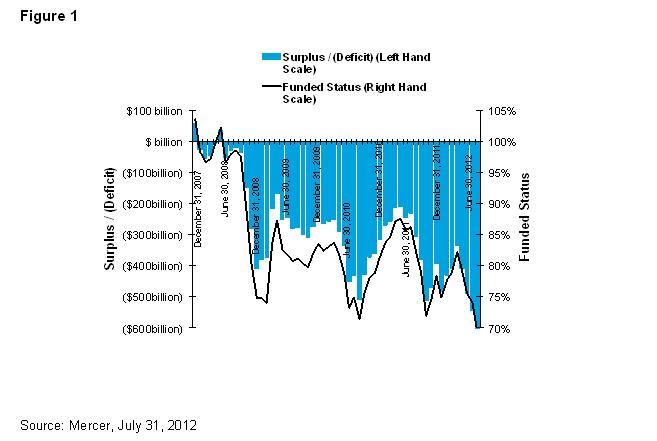The aggregate deficit in pension plans sponsored by S&P 1500 companies
grew $146 billion during July, to a record high $689 billion, according to new
figures from Mercer[1]. This deficit corresponds to a record low aggregate
funded ratio of 70% as of July 31, 2012, compared to a funded ratio of 74% as of
June 30, 2012, at which point the aggregate deficit was $543 billion.
Although US equity markets rose 1.4% during July[2], discount rates[3] fell another 30 to 55 basis points resulting in
liability increases ranging from 3% to 11% during the month. The continued fall
in US Treasury yields and the narrowing of corporate bond credit spreads led to
discount rates hitting a new all-time low for the third consecutive month.
gThis record deficit proves that pension funded status
volatility is showing no sign of abating, breaking the previous low of 71% at
the end of August 2011,h said Jonathan Barry, a partner with Mercerfs
Retirement, Risk & Finance consulting group. gAs we have turned past the
halfway point for the year, sponsors really need to take a close look at how
these deficits might impact their 2013 financials. Absent a significant rise in
rates over the next five months, sponsors will be looking at higher year-end
balance sheet deficits and P&L expense for 2013.
gNCR's recent announcement of
accelerated cash funding and offering terminated vested participants a lump
sum payment shows that options beyond funding the minimum required can still be
very attractive,h said Kevin Armant, a principal with Mercerfs Financial
Strategy Group. gSponsors also need to take a close look at the impact of market
conditions and recent legislative changes on their funding strategy. Funding
stabilization, enacted as part of MAP-21, will give sponsors an opportunity to
lower near-term contribution requirements. But companies need to also consider
the true economic deficit they are now facing, and may want to contribute more
than is now required in order to help address this record deficit.h
Mr. Armant added: gThe impact
of higher Pension Benefit Guaranty Corporation premiums and the potential
ability to borrow at low rates to meet funding requirements come into play as
well and comparing the alternatives requires careful analysis.h
Mercer estimates the aggregate
combined funded status position of plans operated by S&P 1500 companies on a
monthly basis. Figure 1 shows the estimated aggregate surplus/(deficit) position
and the funded status of all plans operated by companies in the S&P 1500.
This is based on projections of their reported financial statements[4] adjusted from each companyfs financial year-end to July
31 in line with financial indices. This includes US domestic qualified and
non-qualified plans and all non-domestic plans. The estimated aggregate value of
pension plan assets of the S&P 1500 companies at December 31, 2011, was
$1.45 trillion, compared with estimated aggregate liabilities of $1.93 trillion.
Allowing for changes in financial markets through the end of July 2012, changes
to the S&P 1500 constituents and newly released financial disclosures, the
estimated aggregate assets were $1.57 trillion, compared with the estimated
aggregate liabilities of $2.26 trillion as of July 31, 2012.
Notes for editors
Unless otherwise stated, the
calculations are based on the Financial Accounting Standard (FAS) funding
position and include analysis of the S&P 1500 companies.
About Mercer
Mercer is a global leader in human resource consulting and
related services. The firm works with clients to solve their most complex human
capital issues by designing and helping manage health, retirement and other
benefits. Mercerfs 20,000 employees are based in more than 40 countries. Mercer
is a wholly owned subsidiary of Marsh
& McLennan Companies (NYSE: MMC), a global team of professional services
companies offering clients advice and solutions in the areas of risk, strategy
and human capital. With 52,000 employees worldwide and annual revenue exceeding
$10 billion, Marsh & McLennan Companies is also the parent company
of Marsh, a global
leader in insurance broking and risk management; Guy
Carpenter, a global leader in providing risk and reinsurance intermediary
services; and Oliver
Wyman, a global leader in management consulting. For more information,
visit http://www.mercer.com/. Follow Mercer on
Twitter @MercerInsights.


©2012 Mercer LLC, All Rights Reserved